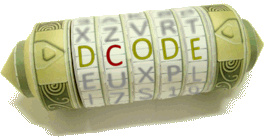Tool to write in Parsons code. Parsons notation (or Melodic Contours) allows the simplification of a musical writing using tone changes in the melody.
Parsons Code - dCode
Tag(s) : Notation System
dCode is free and its tools are a valuable help in games, maths, geocaching, puzzles and problems to solve every day!
A suggestion ? a feedback ? a bug ? an idea ? Write to dCode!
Parsons Code
Parsons Converter
Answers to Questions (FAQ)
What is Parsons code? (Definition)
Parsons code is used to represent the variations of the music which aims to facilitate the search by musical melody contours.
How to convert a melody into Parsons code?
The parsons code represents the first note by an asterisk * (which is sometimes omitted).
The following notes are shown with a letter from U,D,R indicating its relationship with the previous note:
Example: U for up: the pitch is higher than the previous note
D to down: the pitch is lower than the previous note
R for repeat: the pitch is the same as the previous note
Where to get a music with Parsons code?
A search is possible on Musipedia here
Tools for music recognition like Google or Shazam use this method (among others) to recognize a melody.
dCode offers tools for reading musical note sheets.
When Parsons code was invented?
In 1975, Denys Parsons has developed the Parsons Code in his book here (affiliate link)
Source code
dCode retains ownership of the "Parsons Code" source code. Any algorithm for the "Parsons Code" algorithm, applet or snippet or script (converter, solver, encryption / decryption, encoding / decoding, ciphering / deciphering, breaker, translator), or any "Parsons Code" functions (calculate, convert, solve, decrypt / encrypt, decipher / cipher, decode / encode, translate) written in any informatic language (Python, Java, PHP, C#, Javascript, Matlab, etc.) or any database download or API access for "Parsons Code" or any other element are not public (except explicit open source licence). Same with the download for offline use on PC, mobile, tablet, iPhone or Android app.
Reminder: dCode is an educational and teaching resource, accessible online for free and for everyone.
Cite dCode
The content of the page "Parsons Code" and its results may be freely copied and reused, including for commercial purposes, provided that dCode.fr is cited as the source (Creative Commons CC-BY free distribution license).
Exporting the results is free and can be done simply by clicking on the export icons ⤓ (.csv or .txt format) or ⧉ (copy and paste).
To cite dCode.fr on another website, use the link:
In a scientific article or book, the recommended bibliographic citation is: Parsons Code on dCode.fr [online website], retrieved on 2025-12-15,
